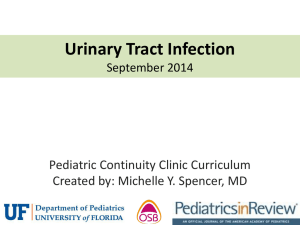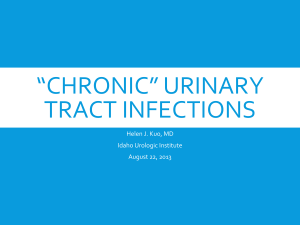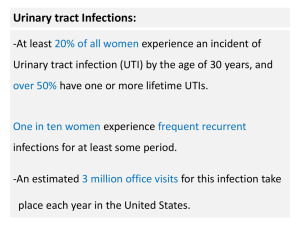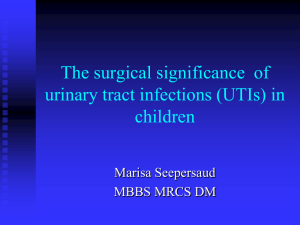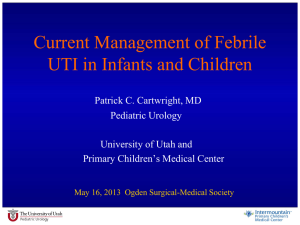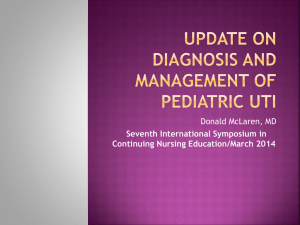Pediatric Urinary Tract Infections
advertisement
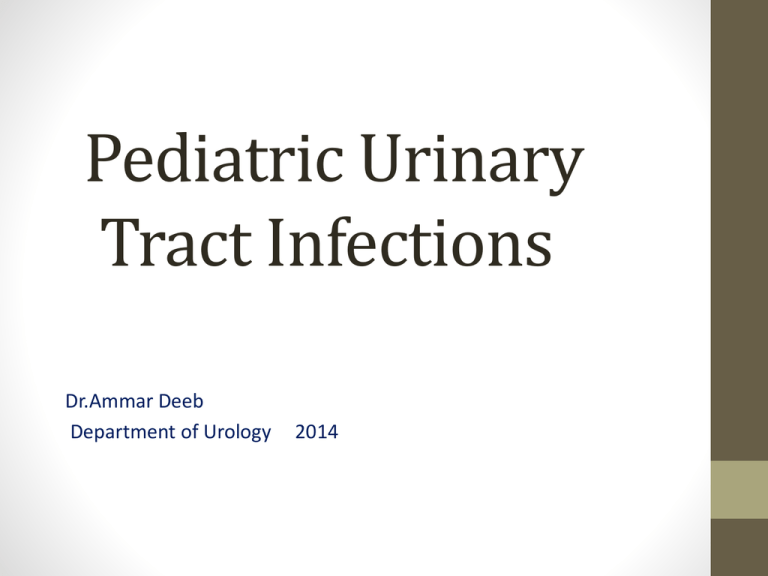
Pediatric Urinary Tract Infections Dr.Ammar Deeb Department of Urology 2014 Introduction • In infants and children, the urinary tract is a relatively common site of infection. • Urinary Tract Infections(UTIs) result in significant acute morbidity , as well as long-term medical problems including : delayed Hypertension and progressive renal dysfunction Why do UTIs in children have that much importance? • Difficulty of diagnosis : unclear clinical features – • Accurate diagnosis and timely treatment are vital in limiting theses long-term sequelae, because the pediatric kidney is susceptible to scarring and permanent renal damage • UTI results in recognition of some important underlying structural or neurogenic abnormality of the urinary tract Incidence • The incidence of UTIs in the pediatric population varies based on gender and age • Occurrences of first-time, symptomatic UTIs are highest in boys and girls during the first year of life and markedly decrease after that • overall prevalence of UTI in infants presenting with fever was 7.0% • By age, the rates in girls were as follows: 0-3 months - 7.5% 3-6 months - 5.7% 6-12 months - 8.3% >12 months - 2.1% • In febrile boys less than 3 months of age, 2.4% of circumcised boys and 20.1% of uncircumcised boys had a UTI. • During the first six months of life uncircumcised males have a 10 to 12-fold increased risk compared to circumcised males for development of UTIs • Only during the first year of life do males have a higher incidence of UTIs when compared to females. Pathogenesis of urinary tract infection Mechanism Of Infection Ascending way Hematogenous Lymphatic Direct Extension • uropathogens colonized the periurethral area ascend to the bladder. can spread up the urinary tract to the kidneys and possibly to the bloodstream (bacteremia). • Urine is normally sterile. • Entry of bacteria can result from turbulent flow during normal voiding, voiding dysfunction, or catheterization • sexual intercourse or genital manipulation may foster the entry of bacteria into the urinary bladder • Hematogenous spread is uncommon and usually occurs in children who are immunocompromised ,during systemic bacteremia (sepsis) Organisms that may spread hematogenously to the urinary tract include Staphylococcus aureus, Candida species, and tuberculosis • Genitourinary tract fistulas, such as vesicovaginal can result in UTI infections by direct extension Aetiology • Bacterial infections, with E coli being the most frequent pathogen, causing 75-90% of UTIs. Other bacterial : • • • • Klebsiella species Proteus species Enterococcus species Staphylococcus saprophyticus, especially among female adolescents and sexually active females • Streptococcus group B, especially among neonates • Pseudomonas aeruginosa • Fungi (Candida species) especially after instrumentation • Adenovirus is a rare cause of hemorrhagic cystitis Risk Factors Alteration of flora Anatomic anomalybladder dysfunction Constipation Circumcision Risk factors • Alteration of the periurethral flora by antibiotic therapy • Children who receive antibiotics (eg, amoxicillin, cephalexin) for other infections are at increased risk for UTI. • These agents may alter gastrointestinal (GI) and periurethral flora, disturbing the urinary tract's natural defense against colonization by pathogenic bacteria Anatomic anomaly------ VUR • VUR is common in children with UTI. • Epidemiologic surveys have shown that between 21% and 57% of children who have had bacteriuria are subsequently found to have VUR. • However, no correlation between reflux and UT predisposition has been found. • The importance of reflux lies in the fact that it allows bladder bacteria renal access with subsequent potential for renal damage. • Bladder dysfunction • Many Studies did not establish causality between UTI and voiding dysfunction, UTI may initiate symptoms of bladder dysfunction with variable persistence. • In some situations, treatment of constipation or voiding abnormalities, or both, has resulted in decreased frequency of urinary infections. • Circumcision and UTI • For male infants, neonatal circumcision substantially decreases the risk of UTI. • during the first year of life, the rate of UTI was 2.15% in uncircumcised boys, versus 0.22% in circumcised boys. • Risk is particularly high during the first 3 months of life. • in febrile boys younger than 3 months, UTI was present in 2.4% of circumcised boys and in 20.1% of uncircumcised boys • Consider circumcision of male neonates. • The AAP policy statement on circumcision is that • “the health benefits of newborn male circumcision outweigh the risks and that the procedure's benefits justify access to this procedure for families who choose it” CLASSIFICATION • Previously, UTIs were classified in numerous descriptive ways such as complicated versus uncomplicated, or upper versus lower tract. • For practical purposes, pediatric UTIs may simply be categorized into two types: first infections and recurrent infections. • • • • The recurrent infections may then be categorized as )1(unresolved bacteriuria during therapy, (2) bacterial persistence at an anatomic site, (3) re-infections. DIAGNOSIS • The febrile infant or child who has no other site of infection to explain the fever, even in the absence of systemic symptoms, should be assessed for the likelihood of pyelonephritis (upper UTI). • Most episodes of UTI during the first year of life are pyelonephritis. • Guidelines from the American Academy of Pediatrics recommend considering the diagnosis of UTI in patients aged 2 months to 2 years with unexplained fever. • identify any risk factors for the UTI. (recent broad-spectrum antibiotic therapy, an anatomic anomaly, voiding dysfunction, and constipation.) SIGNS and SYMPTOMS: • The history and clinical course of a UTI vary with the patient's age and the specific diagnosis. • No one specific sign or symptom can be used to identify UTI in infants and children. • Children aged 0-2 months • usually do not have symptoms localized to the urinary tract. UTI is discovered as part of an evaluation for neonatal sepsis. • Neonates with UTI may display the following symptoms: Jaundice Fever Failure to thrive Poor feeding Vomiting Irritability • Infants and children aged 2 months to 2 years Infants with UTI may display the following symptoms: Poor feeding Fever Vomiting Strong-smelling urine Abdominal pain Irritability • Children aged 2-6 years • Preschoolers with UTI can display the following symptoms: Vomiting Abdominal pain Fever Strong-smelling urine Enuresis Urinary symptoms (dysuria, urgency, frequency) • Children older than 6 years and adolescents School-aged children with UTI can display the following symptoms: Fever Vomiting, abdominal pain Flank/back pain Strong-smelling urine Urinary symptoms (dysuria, urgency, frequency) Enuresis Incontinence ??! • Physical examination findings in pediatric patients with UTI can be summarized as follows: • Costovertebral angle tenderness • Abdominal tenderness to palpation • Suprapubic tenderness to palpation • Palpable bladder • Dribbling, poor stream, or straining to void URINE ANALYSIS • The diagnosis of UTI is predicated on obtaining a good urinary specimen, which can be difficult in children. Routinely, there are four ways that urinary specimens are obtained in children. In order of least to most reliable for UTI diagnosis, they are • )1(plastic bag attached to the perineum • )2(midstream void, • (3) catheter specimen, or • (4) a suprapubic bladder aspirate • (AAP) criteria for the diagnosis of UTI in children 2-24 months are the presence of pyuria and/or bacteriuria on urinalysis and of at least 50,000 (CFU) per mL of a uropathogen. • In neonates younger than 2 months of age, criteria include the presence of lower amounts of a single pathogen (10,00050,000 CFU/mL.) • Significant pyuriais defined as >10 WBC/mm3. • The concentration of motile bacteria can also be quantified, with 107 bacteria per ml being deemed significant. This figure corresponds to 8 organisms per highpowered field. • The gold standard for the diagnosis of UTI is quantitative urinary culture. Haematology Studies: • Hematologic studies do not tend to help in the diagnosis of UTIs, although they should be obtained in patients who appear ill. • Obtain a complete blood count (CBC) and basic metabolic panel for children with a presumptive diagnosis of pyelonephritis. • Perform blood cultures in febrile infants and older patients who are clinically ill, toxic, or severely febrile. • Renal function can be measured by serum creatinine and blood urea nitrogen (BUN) levels; both may be elevated in severe disease • Electrolyte abnormalities may be present. • Procalcitonin, a propeptide of calcitonin that has been found to be elevated in response to bacterial endotoxins, has shown promise in helping to diagnose pyelonephritis and early renal damage. Imaging Studies • Imaging evaluation is important to the diagnosis and management of UTI with the goal of altering or preventing further morbidity • It should be kept in mind that imaging studies are recommended only if their findings may change clinical management . Necessary V/S Not cost-effective it's important to adopt a selective approach which avoids submitting normal children to unnecessarily invasive and costly investigations while at the same time identifying those children who have significant abnormalities such as reflux and renal scarring. The clinician's judgment should guide the decision regarding imaging studies, rather than a rigid rule • Imaging studies are not indicated for infants and children with a first episode of cystitis or for those with a first febrile UTI who meet the following criteria: Assured follow-up Prompt response to treatment (afebrile within 72 h) A normal voiding pattern (no dribbling) No abdominal mass Ultrasonography Ultrasonography of the urinary tract is the imaging initial study of choice in children with UTI Urinary ultrasonography is safe, noninvasive study, and easy to perform. It is useful in excluding obstructive uropathy, as well as in identifying a solitary or ectopic kidney and, in some cases, moderate renal damage caused by pyelonephritis Indications for renal and bladder ultrasonography: Febrile UTI in infants aged 2-24 months. Delayed or unsatisfactory response to treatment of a first febrile UTI An abdominal mass or abnormal voiding (dribbling of urine) Recurrence of febrile UTI after a satisfactory response to treatment Finally, renal ultrasonography should be considered for any child with a first febrile UTI in whom good follow-up cannot be ensured. (VCUG(Voiding cystourethrography • may be indicated after a first febrile UTI if renal and bladder ultrasonography reveal hydronephrosis, scarring, obstructive uropathy, or masses or if complex medical conditions are associated with the UT • VCUG is recommended after a second episode of febrile UT even if previous ultrasonographic examination findings were unremarkable • Children who respond to treatment for a UTI but afterwards demonstrate an abnormal voiding pattern may need to undergo standard VCUG • The routine use of VCUG after the first UTI is not recommended, since data do not support the use of antimicrobial prophylaxis to prevent recurrent febrile UTI in infants unless they have VUR above grade 4. DMSA Scan • DMSA imaging to detect renal scars is indicated in the clinically high-risk group. younger than 1 year of age who present with systemic symptoms, may have an unusual microorganism in their urine, show resistance to antibiotic treatment, have started treatment with antibiotics late. TREATMENT • Start antibiotics after performing urinalysis and obtaining a urine specimen for culture in patients with UTI • Empiric antibiotics should be chosen for coverage of the most common uropathogens, namely Escherichia coli and Enterococcus, Proteus, and Klebsiella species • Patients with a nontoxic appearance may be treated with oral fluids and antibiotics. • Toxic-appearing patients must be aggressively treated with intravenous (IV) fluids and parenteral antibiotics. • IV until the patient is afebrile for 24 hours. • Complete 10-14 days of therapy with an oral antibiotic • Hospitalization is necessary for the following patients with UTI: Patients who are toxemic or septic Patients with signs of urinary obstruction or significant underlying disease Patients unable to tolerate adequate oral fluids or medications Infants younger than 2 months with febrile UTI (presumed pyelonephritis) All infants younger than 1 month with suspected UTI, even if not febrile • For parenteral therapy in a patient who is not allergic to cephalosporins, initial treatment may consist of a single dose of ceftriaxone (75 mg/kg IV/IM q12-24h). • If the patient has cephalosporin allergy, initial treatment may be with gentamicin (2.5 mg/kg IV/IM as a single dose). • switched to an oral antibacterial agent at therapeutic doses within the next 12-18 hours Empiric therapeutic regimes for pediatric urinary tract infections : • Age < 2mo • Cefotaxime 150 mg/kg/day IV/IM divided q6-8h plus ampicillin 100 mg/kg/day IV/IM divided q8h or • Ceftriaxone 50-75 mg/kg/day IV/IM as a single dose or divided q12h (ceftriaxone should not be used in infants younger than 6wk) or • Ampicillin 100 mg/kg/day IV/IM divided q8h plus gentamicin 3.5-5 mg/kg/dose IV q24h if patient younger than 7d, otherwise gentamicin 5-7.5 mg/kg/dose IV q24h • Transition to oral antibiotic active against the offending organism after 24-48h for total of 14d course Age 2mo to 18y Outpatient therapy: Nitrofurantoin 5-7 mg/kg PO divided q6h for 3-10d or Trimethoprim (TMP) and sulfamethoxazole 5-10 mg/kg/day PO divided q12h, based on TMP component, for 3-10d or Amoxicillin and clavulanic acid 20-40 mg/kg divided q8h for 310d or Cephalexin 25-50 mg/kg/day PO divided q6h, not to exceed 3 g/day, for 10d Inpatient therapy: Ceftriaxone 50-75 mg/kg/day IV/IM as a single dose or divided q12h plus ampicillin 100 mg/kg/day IV/IM divided q8h or Cefotaxime 150 mg/kg/day IV/IM divided q6-8h plus ampicillin 100 mg/kg/day IV/IM divided q8h or Ampicillin 100 mg/kg/day IV/IM divided q8h plus gentamicin 57.5 mg/kg/dose IV q24h Transition to oral antibiotic active against the offending organism after 24-48h Cystitis • Children with cystitis usually do not require special medical care other than appropriate antibiotic therapy and symptomatic treatment if voiding symptoms are marked. • A 4-day course of an oral antibiotic agent is recommended for the treatment of cystitis Antimicrobial Prophylaxis • Because renal scarring and damage have been shown to occur only in the presence of infection, the goal of antimicrobial prophylaxis is to sterilize the urine and prevent infection. The subject of sterile scars was contentious for many years that sterile segmental scarring can be acquired only in extreme hydrodynamic conditions amounting to obstruction, when VUR is combined with severe bladder outflow obstruction resulting in retention of urine, upper tract dilation, and sustained high pressures within the urinary tract. Sterile Reflux Nephropathy : Parenchymal damage occurrs only when the urodynamic abnormality was sufficient to cause a delay in renal excretion rate (i.e., the presence of obstruction). • . In a recent multicenter studies, • antimicrobial prophylaxis did not decrease the risk of recurrent UTI or the development of renal scarring in children with low-grade reflux (grades I to III) compared with controls. • However, for children with high-grade reflux (grades IV and V), retrospective data have shown that reflux nephropathy is less likely in children with high-grade VUR who present without UTI • In a study of 607 children with reflux diagnosed by VCUG the subjects were randomized to antibiotic prophylaxis with TMP-SMX or placebo • The risk of recurrences was reduced by 50% in the treatment group. • The risk of renal scarring overall did not differ significantly between the groups over 2 years. • Also, the occurrence of a subsequent UTI with a TMP-SMX — resistant organism was significantly increased in the treatment group. Prognosis • Mortality related to UTI is exceedingly rare in otherwise healthy children in developed countries • Cystitis may cause voiding symptoms and require antibiotics, but it is not associated with long-term, deleterious kidney damage. • The voiding symptoms are usually transient, clearing within 24-48 hours of effective treatment • Morbidity associated with pyelonephritis is characterized by systemic symptoms, such as fever, abdominal pain, vomiting, and dehydration. • Bacteremia and clinical sepsis may occur • Dehydration is the most common acute complication. Intravenous fluid replacement is necessary in more severe cases Renal Abscesses Renal abscesses result from a severe infection that leads to liquefaction of renal tissue; this area is subsequently sequestered, forming an abscess. They can rupture out into the perinephric space, forming perinephric abscesses. When the abscesses extend beyond the Gerota's fascia, paranephric abscesses develop Abscesses that form in the renal cortex are likely to arise from hematogenous spread, whereas those in the corticomedullary junction are caused from gram-negative bacteria in conjunction with some other underlying urinary tract abnormalities, such as stones or obstruction. Pyonephrosis • Pyonephrosis refers to bacterial infection of a hydronephrotic, obstructed kidney, which leads to suppurative destruction of the renal parenchyma and potential loss of renal function. Because of the extent of the infection and the presence of urinary obstruction, sepsis may rapidly ensue, requiring rapid diagnosis and management • focal inflammation of the kidney (focal pyelonephritis) or renal abscess. Any inflammation of the renal parenchyma may lead to scar formation. • Approximately 10-30% of children with UTI develop some renal scarring; however, the degree of scarring required for the development of long-term sequelae is unknown. • Long-term complications of pyelonephritis are hypertension, impaired renal function, and end-stage renal disease.
